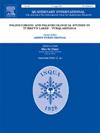Upper Pleistocene in Mallorca: Sedimentary variability of littoral units in relation to different structural contexts
IF 1.9
3区 地球科学
Q3 GEOGRAPHY, PHYSICAL
引用次数: 0
Abstract
This comprehensive study explores the Upper Pleistocene geological history of Mallorca, employing a multidisciplinary approach that integrates previous findings with new insights. The research spans various coastal regions, focusing on four distinct study areas characterized by different geomorphological and structural contexts. The first structural context, exemplified by Port des Canonge, showcases a fold and thrust sedimentary succession, resulting in prominent cliffs with Jurassic and Triassic formations. The second context, observed in Caloscamps, features smoother reliefs and notable terrestrial sediment input. Meanwhile, the third context, represented by Punta de s’Avançada and Punta de n’Amer, exhibits cliffs carved on Upper Miocene tabular units devoid of terrestrial sediment input. The main objective is to provide a comprehensive understanding of the geological and sedimentological characteristics of the Upper Pleistocene units across the Mallorca coastal regions by investigating different study areas located along the west, north-west, north-east, and east coasts, in distinct geomorphological and geological contexts using sedimentological methodologies: stratigraphic analysis, X-ray diffraction analysis, microscopic techniques, and assessment of sediment color. Additionally, Optically Stimulated Luminescence (OSL) dating techniques are employed, providing a precise temporal framework spanning Marine Isotope Stage 6 (MIS 6) to Marine Isotope Stage 3 (MIS 3). The findings reveal the complex interplay of environmental factors, climatic variations, and geological evolution across Mallorca. Colluvial deposits and paleosols reflect climatic shifts. Alluvial fans and aeolianites highlight periods of intense sediment transport and deposition linked to climate fluctuations. Finally, to provide a comprehensive overview of the outcrops present on the island, a stratigraphic correlation of the mentioned areas was conducted. In conclusion, the study enhances our comprehension of the regional coastal dynamics, geological composition, and environmental history, providing invaluable contributions to the broader understanding of Pleistocene deposits.
马略卡岛上更新世:不同结构背景下沿岸单元的沉积变异性
这项综合研究探讨了马略卡岛上更新世的地质历史,采用了一种多学科方法,将以往的研究成果与新的见解相结合。研究横跨多个沿海地区,重点关注四个不同的研究区域,这些区域具有不同的地貌和结构背景。第一个结构背景以卡农格港为例,展示了褶皱和推力沉积演替,形成了侏罗纪和三叠纪地层的突出悬崖。第二种情况出现在卡洛斯坎普斯(Caloscamps),这里的地形较为平缓,陆地沉积物较多。与此同时,以 Punta de s'Avançada 和 Punta de n'Amer 为代表的第三种地貌则是在上新世岩层上雕凿的悬崖,没有陆相沉积。主要目的是通过对位于西海岸、西北海岸、东北海岸和东海岸的不同研究区域进行调查,在不同的地貌和地质背景下,利用沉积学方法:地层分析、X 射线衍射分析、显微技术和沉积物颜色评估,全面了解马略卡岛沿海地区上更新世单元的地质和沉积学特征。此外,还采用了光学激发发光(OSL)测年技术,提供了从海洋同位素阶段 6(MIS 6)到海洋同位素阶段 3(MIS 3)的精确时间框架。研究结果揭示了整个马略卡岛环境因素、气候变化和地质演变之间复杂的相互作用。冲积沉积物和古溶胶反映了气候的变化。冲积扇和风化岩突显了与气候波动相关的沉积物强烈迁移和沉积时期。最后,为了全面概述岛上的露头,我们对上述地区进行了地层对比。总之,这项研究增强了我们对区域海岸动态、地质构成和环境历史的理解,为更广泛地了解更新世沉积物做出了宝贵贡献。
本文章由计算机程序翻译,如有差异,请以英文原文为准。
求助全文
约1分钟内获得全文
求助全文
来源期刊

Quaternary International
地学-地球科学综合
CiteScore
5.60
自引率
4.50%
发文量
336
审稿时长
3 months
期刊介绍:
Quaternary International is the official journal of the International Union for Quaternary Research. The objectives are to publish a high quality scientific journal under the auspices of the premier Quaternary association that reflects the interdisciplinary nature of INQUA and records recent advances in Quaternary science that appeal to a wide audience.
This series will encompass all the full spectrum of the physical and natural sciences that are commonly employed in solving Quaternary problems. The policy is to publish peer refereed collected research papers from symposia, workshops and meetings sponsored by INQUA. In addition, other organizations may request publication of their collected works pertaining to the Quaternary.
 求助内容:
求助内容: 应助结果提醒方式:
应助结果提醒方式:


